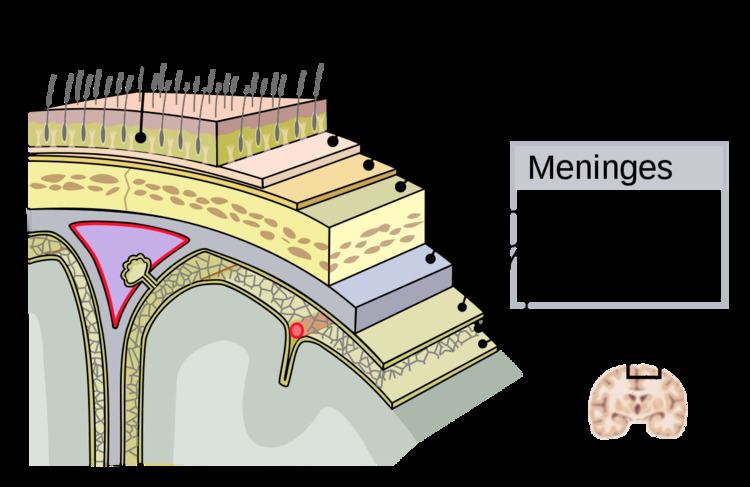Specialty neurology ICD-9-CM 321.2 MeSH D008587 | ICD-10 G0.2 eMedicine article/1168529 | |
 | ||
Viral meningitis is a type of meningitis due to a viral infection. It results in inflammation of the meninges (the membranes covering the brain and spinal cord). Symptoms commonly include headache, fever, sensitivity to light, and neck stiffness.
Contents
Viruses are the most common cause of aseptic meningitis. Most cases of viral meningitis are caused by enteroviruses (common stomach viruses). However, other viruses can also cause viral meningitis. For instance, West Nile virus, mumps, measles, herpes simplex types I and II, varicella, and lymphocytic choriomeningitis (LCM) virus. Based on clinical symptoms, viral meningitis cannot be reliably differentiated from bacterial meningitis, although viral meningitis typically follows a more benign clinical course. Viral meningitis has no evidence of bacteria present in cerebral spinal fluid (CSF). Therefore, lumbar puncture with CSF analysis is often needed to identify the disease.
In most causes there is no specific treatment, with efforts generally aimed at relieving symptoms (headache, fever, or nausea). A few viral causes, such as HSV, have specific treatments.
In the United States viral meningitis is the cause of greater than half of all cases of meningitis. From 1988–1999, about 36,000 cases occurred a year. While the disease can occur in both children and adults it is more common in children.
Signs and symptoms
Like other causes of meningitis, viral meningitis characteristically presents with fever, headache and neck stiffness. In contrast to bacterial meningitis, symptoms are often less severe and do not progress as quickly. Nausea, vomiting and photophobia (light sensitivity) also commonly occur, as do general signs of a viral infection, such as muscle aches and malaise. Of note, infants with viral meningitis may only appear irritable, sleepy or have trouble eating. In severe cases, people may experience concomitant encephalitis (meningoencephalitis), which is suggested by symptoms such as altered mental status, seizures or focal neurologic deficits.
Causes
The viruses that cause meningitis are typically acquired from sick contacts. However, in most cases, people infected with viruses may cause meningitis do not actually develop meningitis.
Viruses that can cause meningitis include:
Diagnosis
The diagnosis of viral meningitis is made by clinical history, physical exam, and several diagnostic tests. Most importantly, cerebrospinal fluid (CSF) is collected via lumbar puncture (also known as spinal tap). This fluid, which normally surrounds the brain and spinal cord, is then analyzed for signs of infection. CSF findings that suggest a viral cause of meningitis include an elevated white blood cell count (usually 10-100 cells/µL) with a lymphocytic predominance in combination with a normal glucose level. Increasingly, cerebrospinal fluid PCR tests have become especially useful for diagnosing viral meningitis, with an estimated sensitivity of 95-100%. Additionally, samples from the stool, urine, blood and throat can also help to identify viral meningitis.
In certain cases a CT scan of the head should be done before a lumbar puncture such as in those with poor immune function or those with increased intracranial pressure.
Treatment
Herpes simplex virus, varicella zoster virus and cytomegalovirus have a specific antiviral therapy; most other viruses do not. For herpes the treatment of choice is aciclovir.
Epidemiology
In the United States from 1988–1999, about 36,000 new cases of viral meningitis occur each year. The disease can occur in both children and adults. During an outbreak in Romania and in Spain viral meningitis was more common among adults. While, people aged younger than 15 made up 33.8% of cases. In contrast in Finland in 1966 and in Cyprus in 1996, Gaza 1997, China 1998 and Taiwan 1998, the incidences of viral meningitis were more common among children.
